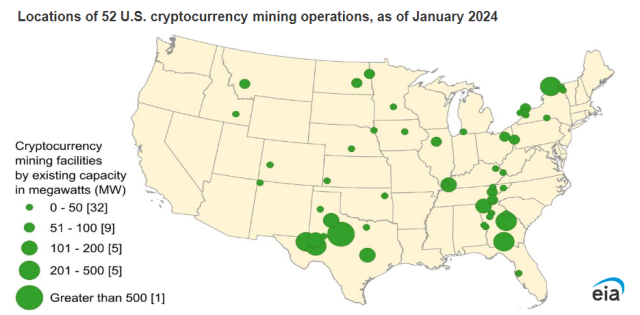Latest news about Bitcoin and all cryptocurrencies. Your daily crypto news habit.
The US government has set its sights on the burgeoning crypto mining industry, launching a data-gathering initiative to assess its environmental impact, particularly its energy consumption.
White House Directs EIA: Probing Crypto’s Energy Use
The Energy Information Administration (EIA), under an urgent directive from the White House, will embark on a mission to engage directly with commercial digital currency miners and collect comprehensive details on their energy usage patterns and sources.
This move comes amidst growing concerns about the environmental footprint of mining operations, particularly those dedicated to Bitcoin (BTC), which utilizes a resource-intensive “proof-of-work” system.
Understanding how the energy demand for cryptocurrency mining is changing and identifying regions with rapid expansion are among their key focuses, Joe DeCarolis, Administrator of the EIA, said.
This initiative stems from heightened attention to the potential environmental harms associated with bitcoin mining, including strain on power infrastructure, spikes in electricity prices, and increased carbon emissions contributing to climate change.
Rising Demand, Growing Concerns
Preliminary assessments by the EIA reveal that cryptocurrency mining gobbles up a staggering 0.6% to 2.3% of the nation’s electricity consumption, equivalent to the total power draw of states like Utah or West Virginia.
The rapid upsurge of the industry, which boomed after operations shifted from China to the US following the Asian giant’s crypto crackdown, has raised concerns about its sustainability.
One major worry is the potential strain on US power infrastructure. In some instances, dormant fossil fuel plants have even been revived to meet the surging power demands of crypto-mining hubs. This raises concerns about the industry’s contribution to greenhouse gas emissions and its potential to undermine efforts to combat climate change.
Nomadic Miners And Regulatory Challenges
Further complicating the issue is the nomadic nature of mining operations. These businesses frequently migrate to regions with lower power costs and less stringent regulations, making it difficult to track their impact and enforce environmental standards. This migratory behavior also presents challenges for grid planners struggling to keep up with fluctuating demands.
The article published in the Wall Street Journal highlights the contrasting energy consumption between Bitcoin’s proof-of-work system and the more energy-efficient proof-of-stake method adopted by other cryptocurrencies like Ethereum (ETH). This suggests that technological advancements could play a significant role in reducing the industry’s environmental footprint.
Democratic legislators have vocalized their concerns and urged federal authorities to closely monitor and mitigate the energy and environmental impacts of crypto mining. Industry experts anticipate stricter regulations and mandatory disclosures on emissions and energy consumption in the near future.
Featured image from Adobe Stock, chart from TradingView
Disclaimer
The views and opinions expressed in this article are solely those of the authors and do not reflect the views of Bitcoin Insider. Every investment and trading move involves risk - this is especially true for cryptocurrencies given their volatility. We strongly advise our readers to conduct their own research when making a decision.
